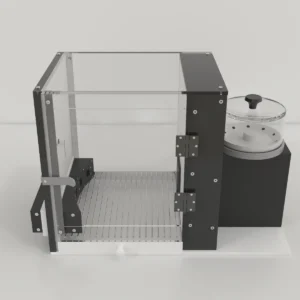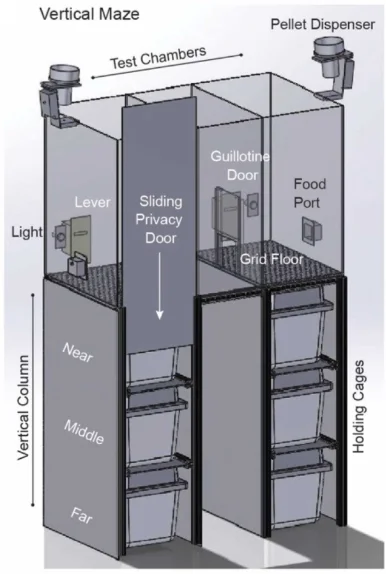$3,990.00 – $4,990.00Price range: $3,990.00 through $4,990.00
The 3d Vertical Maze is an innovative, modular tool designed to investigate the interplay between social and spatial cognition in rats and mice. Based on the publication “The 3D Vertical Maze: A new model system for studying the interactions between social and spatial cognition“. The authors aimed to study realistic social and spatial behaviors beyond the confines of the traditional 2D 3-chamber Sociability or Operant paradigms.

MazeEngineers empowers preclinical neuroscience research with meticulously designed, customizable behavioral apparatuses. From manual classic mazes to fully automated smart systems, we provide the tools scientists need to capture high-quality, reproducible data for studies on learning, memory, anxiety, and depression.



bool(false)
Rat Vertical Maze | Mouse |
Opaque acrylic 3-chamber testing platform (90×50 x 60 cm) | Opaque acrylic 3-chamber testing platform (63×35 x 48 cm) |
Two vertical columns (30 ×50 x 90 cm; each) | Two vertical columns (21 ×35 x 63 cm; each) |
Perforated and solid acrylic flooring | Perforated and solid acrylic flooring |
Operant set-up: Automated lever; pellet dispenser; and pellet receptacle |
Lights |
Speakers |
Capacity |
Custom manual or automated guillotine door |
The 3d Vertical Maze is an innovative, modular tool designed to investigate the interplay between social and spatial cognition in rats and mice. Based on the publication “The 3D Vertical Maze: A new model system for studying the interactions between social and spatial cognition“. The authors aimed to study realistic social and spatial behaviors beyond the confines of the traditional 2D 3-chamber Sociability or Operant paradigms.
Key Features of the Vertical Maze:
Three-Dimensional Design: The VM consists of a standard three-chamber maze elevated above multilevel columns. This setup allows for the presentation of conspecifics (other rats or mice) at varying spatial distances and familiarity levels beneath the main chamber.
Multisensory Engagement: By positioning conspecifics below the subject, the maze engages multiple sensory modalities—auditory, visual, and olfactory—enabling rodents to assess distance, direction, and social identity of their peers.
Behavioral Assessments: The apparatus supports both spontaneous exploration and operant conditioning tasks, facilitating the measurement of rats’ ability to discriminate spatial distances and social novelty.

Understanding how rodents navigate complex environments and interpret social cues is central to the study of cognitive neuroscience. Traditional behavioral assays, such as the Operant chamber and 3-chamber Sociability test often examine spatial or social cognition in isolation, limiting insights into how these processes interact in real-world contexts. To address this gap, the Vertical Maze (VM)—a novel, three-dimensional behavioral apparatus was designed to simultaneously assess spatial and social decision-making in rodents.
The VM expands on conventional three-chambered social mazes by adding a vertical dimension, allowing researchers to present social stimuli (i.e., conspecifics) at varying heights and distances. This setup mimics the layered spatial environments rodents naturally encounter and engages multiple sensory modalities including olfaction, vision, and audition. Through both spontaneous exploration and operant conditioning paradigms, the VM enables precise measurements of how animals integrate spatial layout and social information to guide behavior.
By combining multi-level spatial challenges with dynamic social contexts, the VM offers a powerful platform for investigating the neural and behavioral mechanisms underlying complex cognition. It holds particular promise for studying conditions where the integration of spatial and social cues may be disrupted, such as in autism spectrum disorders, schizophrenia, or age-related cognitive decline.
The 3D Vertical maze consists of a 3-chamber testing platform with acrylic walls (90× 50 x 60 cm) positioned above two vertical columns (30 × 50 x 90 cm, each). Opaque acrylic walls ensure that subjects could not see outside of the apparatus (Fig. S1B). The two outer (testing) chambers accommodate interchangeable floors made of wire grid, mesh, or acrylic. Opaque acrylic floors allowed for habituation to the testing chambers only, flooring with access holes allowed for travel between testing chambers and vertical columns, and wire flooring allowed for subject access to conspecifics without physical contact or vertical movement.
Flooring in the middle (start) chamber is composed of opaque acrylic. Optional hardware in each testing chamber can include automated levers, lights, speakers, pellet dispensers and receptacles and an automated guillotine door to control subject access to adjacent chambers.
Two vertical columns positioned below the two outside chambers were designed to accommodate demonstrator holding cages at 29.2 cm, 58.4 cm, and 87.6 cm below the floor of the 3-chamber testing arena. Vertical columns were constructed of T-slotted metal framing.

For this type of experiment, it’s recommended to use both male and female mice or rats 🐭 to ensure the generalizability of the results. The subjects should be divided into two main groups with specific functions:
Experimental Subjects: These animals are the main focus of the study. They will actively explore the maze, navigating its vertical pathways and making decisions. They are subjected to the experimental manipulations (e.g., the presence or absence of social cues).
Stimulus Subjects: These animals play a passive but crucial role. They are placed in the lower chambers of the maze to serve as social cues (conspecifics). Their presence is fundamental to evaluating how social interaction, or the possibility of it, influences the behavior of the experimental subjects. Their function is to simulate a social context that the test animal perceives from the top of the maze.
The Vertical Maze is a unique and highly specialized apparatus designed to study decision-making and exploration in a three-dimensional context. Unlike traditional mazes, which are flat, this design adds a component of ascending and descending.
The VM consists of several columns that rise from a base. Each column has a specific compartment or chamber at its base. This space is intended to hold the stimulus subjects, allowing the animals at the top to see and smell them. The top arena is a free-moving area that allows experimental subjects to move without restriction and gain visual access to the lower compartments. The entire structure should be made of a durable and easy-to-clean material.
Before starting the experiment, it’s vital for the experimental subjects to adapt to the environment to minimize stress and unwanted behaviors that could bias the results. Habituation is carried out over 2 to 3 sessions. During this phase:
The animals are handled gently to get them used to contact with the researchers.
They are introduced to the vertical maze. At this point, no stimulus subjects are present in the lower chambers. This allows the animals to familiarize themselves with the maze’s structure, pathways, and design without the distraction of social cues.
The goal is for the animal to feel secure and explore the maze on its own, ensuring that any behavioral changes in later phases of the experiment are due to the experimental manipulation and not the novelty of the apparatus.
Two main types of tasks were examined using the 3D Vertical Maze:
Rats were introduced to the VM and allowed to explore freely.
Researchers recorded the time spent by rats near different social stimuli (e.g., familiar vs. novel rats; close vs. distant columns).
These tests assessed innate preferences based on social novelty and spatial distance
Rats were trained on a set of operant conditioning tasks designed to evaluate their ability to use social information to guide their behavior and earn a reward. The main objective was for the animals to learn to associate the presence or location of specific social cues (like the presence of another animal) with the availability of a reward (such as food or access to another compartment).
These tasks didn’t just test a simple response to a stimulus; they focused on measuring the rats’ cognitive ability to learn and recall complex spatial-social associations. In other words, they had to remember not only that a social stimulus was relevant, but also where that stimulus was located in the environment to make the correct choice and receive the reinforcement. This approach provides a deeper understanding of how animals process and use social information within a spatial context.
The following parameters can be observed using the 3D Vertical Maze:
The 3D Vertical Maze (VM) was utilized to investigate how rats integrate spatial and social information. Adult Long-Evans rats were used as both experimental subjects and social stimuli.
Two types of behavioral assessments were conducted: spontaneous exploration and operant conditioning. In spontaneous exploration trials, experimental rats were allowed to move freely across the upper maze while conspecifics of varying familiarity (familiar vs. unfamiliar) were positioned in different vertical columns. The objective was to measure time spent in proximity to each social stimulus to assess preferences based on both social novelty and spatial distance. In operant conditioning tasks (when used), rats were trained to associate specific zones or stimuli with rewards, testing their ability to learn and apply spatial-social associations. All behavior was recorded via overhead cameras and analyzed using tracking software to quantify metrics such as time spent near stimulus zones and exploration patterns. Data were statistically analyzed to determine the significance of observed behavioral preferences and learning effects.
Rats were able to discriminate between conspecifics (stimulus rats) based on both social identity (familiar vs. unfamiliar) and spatial positioning (vertical distance).
This indicates that rats naturally combine social and spatial cues during exploration.
Spontaneous Social Preference is Spatially Sensitive
Rats preferred unfamiliar conspecifics, consistent with known social novelty-seeking behavior.
Importantly, this preference varied depending on the vertical location of the conspecifics, showing that spatial distance modulates social interest.
Use of Multisensory Cues
The rats utilized visual, olfactory, and auditory cues to detect and assess the social stimuli, even when there was no direct access.
This supports the validity of the maze for studying naturalistic multisensory processing.
Three-Dimensional Spatial Processing
Rats were capable of navigating and making decisions in a vertically structured environment, demonstrating sophisticated spatial cognition beyond two-dimensional settings.
Potential for Operant Learning
In some conditions, rats were shown to learn associations between specific spatial-social configurations and outcomes (e.g., rewards), indicating that the maze can support conditioning paradigms.
| Dimensions | N/A |
|---|---|
| Species | Mouse, Rat |
There are no questions yet. Be the first to ask a question about this product.